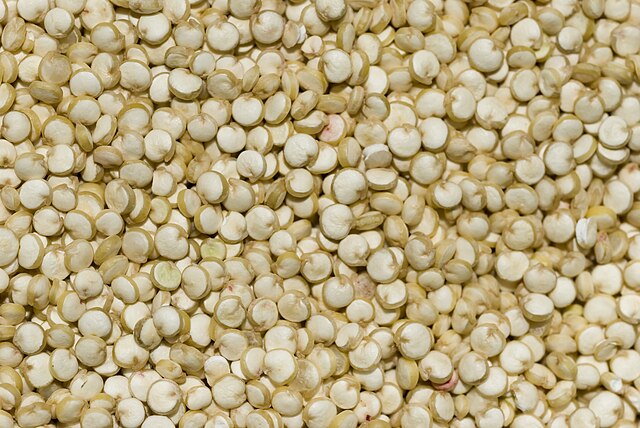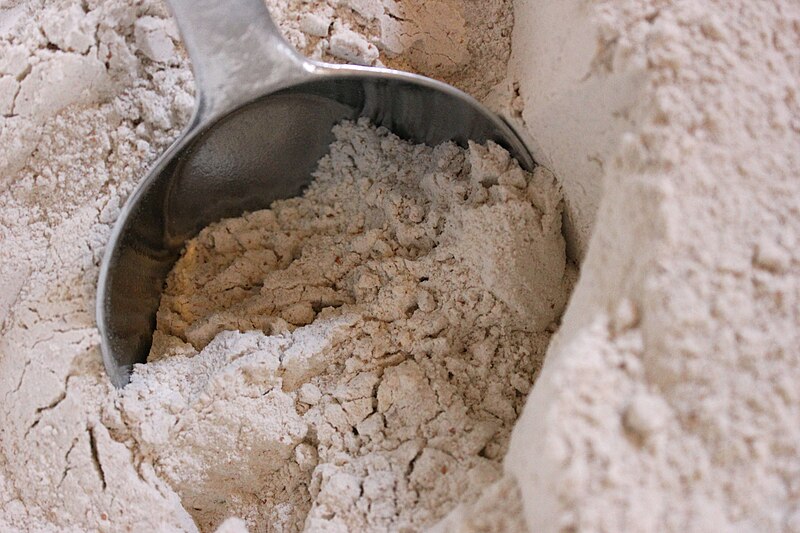Quinoa vs. Whole Wheat Flour
Nutrition comparison of Cooked Quinoa and Whole Wheat Flour
Ever wonder how your favorite foods stack up against each other in terms of nutrition?
We compared the nutritional contents of
cooked
quinoa
versus
whole wheat flour
(100g each)
below using 2020 USDA and NIH data[1].
For a quick recap of significant nutrients and differences in quinoa and whole wheat flour:
- Both quinoa and whole wheat flour are high in calories and dietary fiber.
- Whole wheat flour has more thiamin, niacin and pantothenic acid.
- Whole wheat flour is a great source of protein.
- Whole wheat flour is an excellent source of iron and potassium.
USDA sources for nutritional information: Quinoa (Quinoa, cooked) and Whole Wheat Flour (Wheat flour, whole-grain, soft wheat) . Have a correction or suggestions? Shoot us an email.
Calories and Carbs
calories
Both quinoa and whole wheat flour are high in calories. Whole wheat flour has 177% more calories than quinoa - quinoa has 120 calories per 100 grams and whole wheat flour has 332 calories.
For macronutrient ratios, quinoa is heavier in protein, lighter in carbs and heavier in fat compared to whole wheat flour per calorie. Quinoa has a macronutrient ratio of 15:71:15 and for whole wheat flour, 11:84:5 for protein, carbohydrates and fat from calories.
Macro Ratios from Calories:
| Quinoa | Whole Wheat Flour | |
|---|---|---|
| Protein | 15% | 11% |
| Carbohydrates | 71% | 84% |
| Fat | 15% | 5% |
| Alcohol | ~ | ~ |
carbohydrates
Whole wheat flour is high in carbohydrates and quinoa has 71% less carbohydrates than whole wheat flour - quinoa has 21.3g of total carbs per 100 grams and whole wheat flour has 74.5g of carbohydrates.
dietary fiber
Both quinoa and whole wheat flour are high in dietary fiber. Whole wheat flour has 368% more dietary fiber than quinoa - quinoa has 2.8g of dietary fiber per 100 grams and whole wheat flour has 13.1g of dietary fiber.
sugar
Quinoa and whole wheat flour contain similar amounts of sugar - quinoa has 0.87g of sugar per 100 grams and whole wheat flour has 1g of sugar.
Protein
protein
Whole wheat flour is a great source of protein and it has 118% more protein than quinoa - quinoa has 4.4g of protein per 100 grams and whole wheat flour has 9.6g of protein.
Fat
saturated fat
Both quinoa and whole wheat flour are low in saturated fat - quinoa has 0.23g of saturated fat per 100 grams and whole wheat flour has 0.43g of saturated fat.
Vitamins
Vitamin A
Whole wheat flour and quinoa contain similar amounts of Vitamin A - whole wheat flour has 2.7ug of Vitamin A per 100 grams and quinoa does not contain significant amounts.
Vitamin E
Quinoa and whole wheat flour contain similar amounts of Vitamin E - quinoa has 0.63mg of Vitamin E per 100 grams and whole wheat flour has 0.53mg of Vitamin E.
Vitamin K
Whole wheat flour and quinoa contain similar amounts of Vitamin K - whole wheat flour has 1.9ug of Vitamin K per 100 grams and quinoa does not contain significant amounts.
The B Vitamins
Whole wheat flour has more thiamin, niacin and pantothenic acid. Both quinoa and whole wheat flour contain significant amounts of riboflavin, Vitamin B6 and folate.
| Quinoa | Whole Wheat Flour | |
|---|---|---|
| Thiamin | 0.107 MG | 0.297 MG |
| Riboflavin | 0.11 MG | 0.188 MG |
| Niacin | 0.412 MG | 5.347 MG |
| Pantothenic acid | ~ | 1.011 MG |
| Vitamin B6 | 0.123 MG | 0.191 MG |
| Folate | 42 UG | 28 UG |
Minerals
calcium
Whole wheat flour has 94% more calcium than quinoa - quinoa has 17mg of calcium per 100 grams and whole wheat flour has 33mg of calcium.
iron
Whole wheat flour is an excellent source of iron and it has 149% more iron than quinoa - quinoa has 1.5mg of iron per 100 grams and whole wheat flour has 3.7mg of iron.
potassium
Whole wheat flour is an excellent source of potassium and it has 129% more potassium than quinoa - quinoa has 172mg of potassium per 100 grams and whole wheat flour has 394mg of potassium.
Antioxidants and Phytonutrients
carotenoids
Carotenoids are micronutrients commonly found in plants and some animal products. An example is beta-carotene, the notable carotenoid which is a popular source of Vitamin A.[4][5]
For specific types of carotenoids, both quinoa and whole wheat flour contain small amounts of beta-carotene.
| Quinoa | Whole Wheat Flour | |
|---|---|---|
| beta-carotene | 3 UG | 5 UG |
| lutein + zeaxanthin | 53 UG | 220 UG |
Customize your serving size
The comparison below is by common portions, e.g. cups, packages. You can also see a more concrete comparison by weight at equal weight (by grams) comparison.
Note: The specific food items compared are: Quinoa (Quinoa, cooked) and Whole Wheat Flour (Wheat flour, whole-grain, soft wheat) .
Cooked Quinoa g
()
|
Daily Values (%) |
Whole Wheat Flour g
()
|
|||||
|---|---|---|---|---|---|---|---|
| KCAL % |
|
5% | calories | 5% |
|
KCAL % | |
| G % |
|
5% | carbohydrates | 5% |
|
G % | |
| G % |
|
5% | dietary fiber | 5% |
|
G % | |
| G | 5% | sugar | 5% | G | |||
| G % |
|
5% | total fat | 5% |
|
G % | |
| G % |
|
5% | saturated fat | 5% |
|
G % | |
| G | 5% | monounsaturated fat | 5% | G | |||
| G | 5% | polyunsaturated fat | 5% | G | |||
| G | 5% | trans fat | 5% | G | |||
| MG | 5% | cholesterol | 5% | MG | |||
| MG % |
|
5% | sodium | 5% |
|
MG % | |
| 5% | Vitamins and Minerals | 5% | |||||
| UG % |
|
5% | Vitamin A | 5% |
|
UG % | |
| MG % |
|
5% | Vitamin C | 5% |
|
MG % | |
| IU % |
|
5% | Vitamin D | 5% |
|
IU % | |
| MG % |
|
5% | calcium | 5% |
|
MG % | |
| MG % |
|
5% | iron | 5% |
|
MG % | |
| MG % |
|
5% | magnesium | 5% |
|
MG % | |
| MG % |
|
5% | potassium | 5% |
|
MG % | |
| MG % |
|
5% | thiamin (Vit B1) | 5% |
|
MG % | |
| MG % |
|
5% | riboflavin (Vit B2) | 5% |
|
MG % | |
| MG % |
|
5% | niacin (Vit B3) | 5% |
|
MG % | |
| MG % |
|
5% | Vitamin B6 | 5% |
|
MG % | |
| MG % |
|
5% | pantothenic acid (Vit B5) | 5% |
|
MG % | |
| UG % |
|
5% | folate (Vit B9) | 5% |
|
UG % | |
| UG % |
|
5% | Vitamin B12 | 5% |
|
UG % | |
| MG % |
|
5% | Vitamin E | 5% |
|
MG % | |
| UG % |
|
5% | Vitamin K | 5% |
|
UG % | |
| G % |
|
5% | protein | 5% |
|
G % | |
| UG % |
|
5% | biotin (Vit B7) | 5% |
|
UG % | |
| MG % |
|
5% | choline | 5% |
|
MG % | |
| MG % |
|
5% | chlorine | 5% |
|
MG % | |
| UG % |
|
5% | chromium | 5% |
|
UG % | |
| MG % |
|
5% | copper | 5% |
|
MG % | |
| UG % |
|
5% | fluoride | 5% |
|
UG % | |
| UG % |
|
5% | iodine | 5% |
|
UG % | |
| MG % |
|
5% | manganese | 5% |
|
MG % | |
| UG % |
|
5% | molybdenum | 5% |
|
UG % | |
| MG % |
|
5% | phosphorus | 5% |
|
MG % | |
| UG % |
|
5% | selenium | 5% |
|
UG % | |
| MG % |
|
5% | zinc | 5% |
|
MG % | |
| G | 5% | Water | 5% | G | |||
| G | 5% | Starch | 5% | G | |||
| G | 5% | Alcohol | 5% | G | |||
FAQ
Does quinoa or whole wheat flour contain more calories in 100 grams?Both quinoa and whole wheat flour are high in calories. Whole wheat flour has 180% more calories than quinoa - quinoa has 120 calories in 100g and whole wheat flour has 332 calories.
Does quinoa or whole wheat flour have more carbohydrates?
By weight, whole wheat flour is high in carbohydrates and quinoa has 70% fewer carbohydrates than whole wheat flour - quinoa has 21.3g of carbs for 100g and whole wheat flour has 74.5g of carbohydrates.
Does quinoa or whole wheat flour contain more iron?
Whole wheat flour is an abundant source of iron and it has 150% more iron than quinoa - quinoa has 1.5mg of iron in 100 grams and whole wheat flour has 3.7mg of iron.
Does quinoa or whole wheat flour contain more potassium?
Whole wheat flour is a rich source of potassium and it has 130% more potassium than quinoa - quinoa has 172mg of potassium in 100 grams and whole wheat flour has 394mg of potassium.

